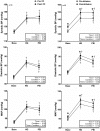The influence of acute elevations in plasma osmolality and serum sodium on sympathetic outflow and blood pressure responses to exercise
- PMID: 29357474
- PMCID: PMC5966729
- DOI: 10.1152/jn.00559.2017
The influence of acute elevations in plasma osmolality and serum sodium on sympathetic outflow and blood pressure responses to exercise
Abstract
Elevated plasma osmolality (pOsm) has been shown to increase resting sympathetic nerve activity in animals and humans. The present study tested the hypothesis that increases in pOsm and serum sodium (sNa+) concentration would exaggerate muscle sympathetic nerve activity (MSNA) and blood pressure (BP) responses to handgrip (HG) exercise and postexercise ischemia (PEI). BP and MSNA were measured during HG followed by PEI before and after a 23-min hypertonic saline infusion (HSI-3% NaCl). Eighteen participants (age 23 ± 1 yr; BMI 24 ± 1 kg/m2) completed the protocol; pOsm and sNa+ increased from pre- to post-HSI (285 ± 1 to 291 ± 1 mosmol/kg H2O; 138.2 ± 0.3 to 141.3 ± 0.4 mM; P < 0.05 for both). Resting mean BP (90 ± 2 vs. 92 ± 1 mmHg) and MSNA (11 ± 2 vs. 15 ± 2 bursts/min) were increased pre- to post-HSI ( P < 0.05 for both). Mean BP responses to HG (106 ± 2 vs. 111 ± 2 mmHg, P < 0.05) and PEI (102 ± 2 vs. 107 ± 2 mmHg, P < 0.05) were higher post-HSI. Similarly, MSNA during HG (20 ± 2 vs. 29 ± 2 bursts/min, P < 0.05) and PEI (19 ± 2 vs. 24 ± 3 bursts/min, P < 0.05) were greater post-HSI. In addition, the change in MSNA was greater post-HSI during HG (Δ9 ± 2 vs. Δ13 ± 3 bursts/min, P < 0.05). A second set of participants ( n = 13, age 23 ± 1 yr; BMI 24 ± 1 kg/m2) completed a time control (TC) protocol consisting of quiet rest instead of an infusion. The TC condition yielded no change in resting sNa+, pOsm, mean BP, or MSNA (all P > 0.05); responses to HG and PEI were not different pre- to post-quiet rest ( P > 0.05). In summary, acutely increasing pOsm and sNa+ exaggerates BP and MSNA responses during HG exercise and PEI. NEW & NOTEWORTHY Elevated plasma osmolality has been shown to increase resting sympathetic activity and blood pressure. This study provides evidence that acute elevations in plasma osmolality and serum sodium exaggerated muscle sympathetic nerve activity and blood pressure responses during exercise pressor reflex activation in healthy young adults.
Keywords: blood pressure regulation; handgrip exercise; osmolality.
Figures




References
Publication types
MeSH terms
Substances
Grants and funding
LinkOut - more resources
Full Text Sources
Other Literature Sources
Medical
Research Materials

